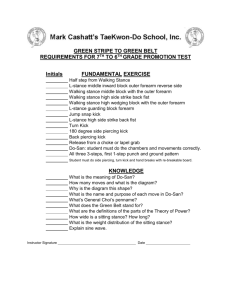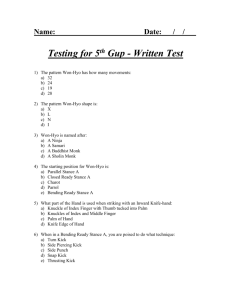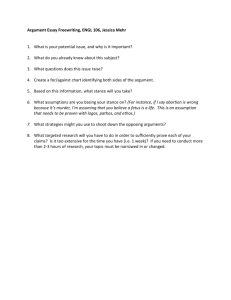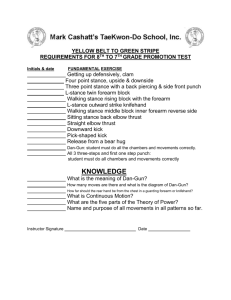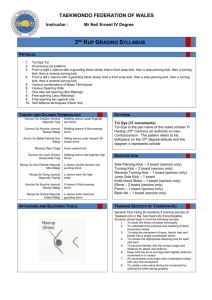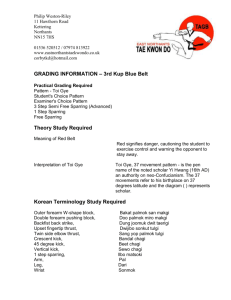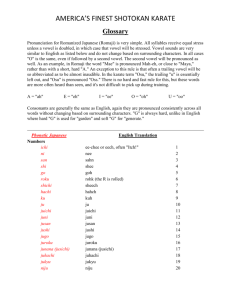Call Sheet Black Belt Grading - Ireland TaeKwondo Association
advertisement
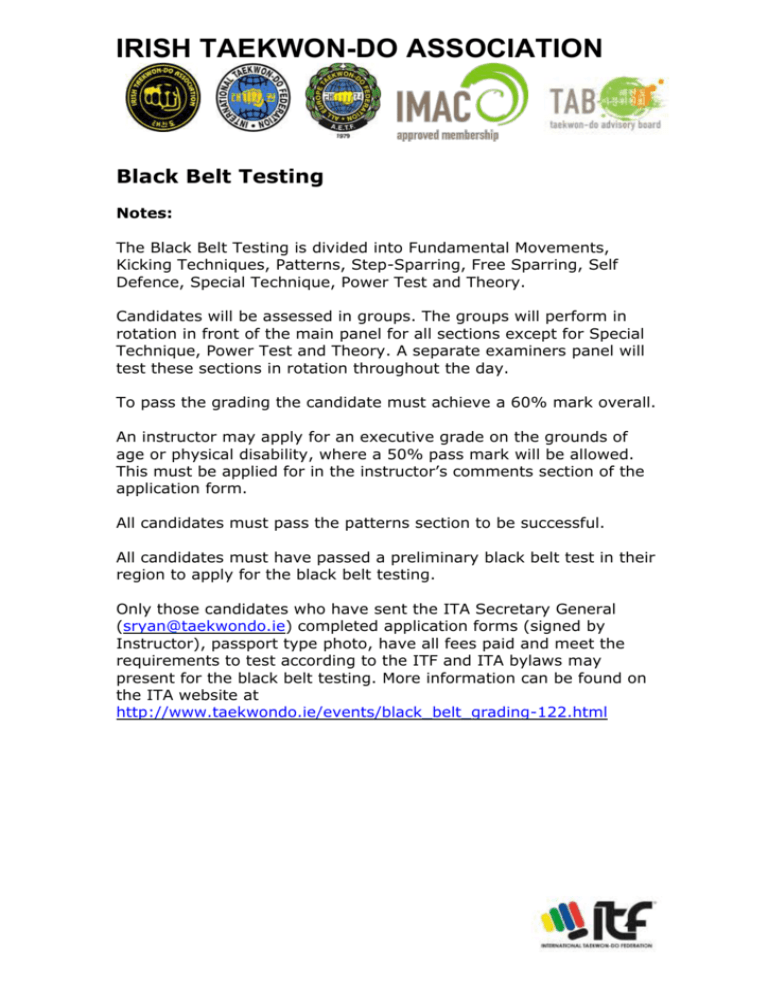
IRISH TAEKWON-DO ASSOCIATION Black Belt Testing Notes: The Black Belt Testing is divided into Fundamental Movements, Kicking Techniques, Patterns, Step-Sparring, Free Sparring, Self Defence, Special Technique, Power Test and Theory. Candidates will be assessed in groups. The groups will perform in rotation in front of the main panel for all sections except for Special Technique, Power Test and Theory. A separate examiners panel will test these sections in rotation throughout the day. To pass the grading the candidate must achieve a 60% mark overall. An instructor may apply for an executive grade on the grounds of age or physical disability, where a 50% pass mark will be allowed. This must be applied for in the instructor’s comments section of the application form. All candidates must pass the patterns section to be successful. All candidates must have passed a preliminary black belt test in their region to apply for the black belt testing. Only those candidates who have sent the ITA Secretary General (sryan@taekwondo.ie) completed application forms (signed by Instructor), passport type photo, have all fees paid and meet the requirements to test according to the ITF and ITA bylaws may present for the black belt testing. More information can be found on the ITA website at http://www.taekwondo.ie/events/black_belt_grading-122.html IRISH TAEKWON-DO ASSOCIATION Gibon Yonsup (Hand techniques) The grading narrator will call hand techniques; the techniques may be called in a different order for each group Each technique will be performed a number of times to allow the candidate to perform with maximum effort and also allow the examiner time to accurately grade the performance 1st Kup Stepping to the left and then to the right; Gojung so digutcha makgi / fixed stance, U-shaped block Stepping forwards/backwards; gunnan so bakat palmok najunde makgi, sonkal chookyo makgi yonsok tongjak / walking stance outer forearm low block, knifehand rising block in continuous motion Stepping backwards/forwards; niunja so sonkal nopunde anuro taerigi, slip the front foot to form gunnan so an palmok dillimyo makgi / L-stance knifehand high inward strike, slip front foot to form walking stance innerforearm circular block Stepping forwards; gunnan so sun sonkut tulgi, jap yosul tae, gunnan so dung joomuk nopunde yop taerigi / walking stance straight fingertip thrust, release from hold and turn into walking stance backfist high side strike (Will need to change legs and perform on opposite side also or turn about) Stepping backwards/forwards; gunnan so sonkal nopunde ap taerigi, sonbadak golcho makgi & ap joomok baro jirugi yon gyol tongjak / walking stance knifehand high front strike, maintain stance palm middle hooking block, observe middle front punch in connecting motion Stepping forwards/backwards; niunja so sang sonkal makgi, nacho so sonbadak noolyo makgi, neurin tongjak; l-stance twin knifehand block, low stance palm pressing block, slow motion Dwiro tora (turn about) Sliding forward, gojung so yop jirugi, soojik so sonkal naeryo taerigi / fixed stance side punch, pulling the front foot into vertical stance knifehand downward strike. IRISH TAEKWON-DO ASSOCIATION 1st Degree 1. Stepping to the left first and then the right: Annun So, sonbadak duro makgi, ap joomuk kaunde jirugi, yon gyol tongjak (sitting stance, scooping block, forefist middle punch, connecting motion – as in Ge Baek #9 & #10) 2. Stepping forwards/backwards: Gunnan so, doo bandalson makgi, ap joomuk dwijibo jirugi (walking stance double arc hand block, forefist upset punch – as in GeBaek #25 & #26) 3. Stepping backwards/forwards: Gunnan so, sang joomuk sewo jirugi, adjust the front foot into niunja so, junji joomuk kaunde jirugi walking stance, twin first vertical punch adjusting the front foot into L-stance middle knuckle middle punch – similar to Ge-Baek #34 & #35) 4. Stepping forwards/backwards: Niunja so dung joomuk nopunde yop taerigi, adjusting the front foot into nacho so sonbadak noolo makgi neurin tongjak (L-stance backfist high side strike, adjusting the front foot into low stance palm pressing block in slow motion) 5. Stepping backwards/forwards: Gunnan so, bakat palmok chookyo makgi, bakat palmok najunde makgi,yonsok tongjak (walking stance outer forearm rising block, outer forearm low block in continuous motion – as in Ge-Baek #5 & #6) 6. Jumping forwards: Kyocha so doo palmok nopunde makgi, move back leg into niunja so sonkal daebi makgi (x stance, double forearm high block, move back leg into lstance knifehand guarding block) IRISH TAEKWON-DO ASSOCIATION 2nd Degree Stepping to the left first and then the right: Annun so, an palmok narani makgi, sonbadak kaunde golcho makgi, ap joomuk kaunde jirugi (sitting stance inner forearm parallel block, palm middle hooking block, forefist middle punch as in Juche #1 - #3) Stepping forward/backwards: Gunnan so, sonkal kaunde hechyo makgi, sonkal dung dollimyo makgi, adjust the front foot into dwitbal so, euhkallin sonbadak naeryo makgi (walking stance knifehand middle wedging block, reverse knifehand circular block, adjusting the front foot into rearfoot stance, alternate palm downward block – as in Eui-Am #27 - #29) Stepping backwards/forwards: Gunnan so, sonkal najunde anuro makgi, doo songarak nopunde bandae tulgi (walking stance knifehand low inward block, double finger high reverse thrust, maintaining stance) Stepping forwards/backwards: Niunja so, kyocha sonkal momchau makgi, adjusting into nacho so sonbadak ollyo makgi (L-stance, x-knifehand checking block, adjusting into low stance, palm upward block) Stepping backwards/forwards: Gunnan so, kyocha joomuk naeryo makgi, sonkal chookyo makgi yonsok tongjak (walking stance, x-fist downward block, knifehand rising block continuous motion – as in Eui-Am #5 and #6) Stepping forwards/backwards: Gunnan so bandal jirugi, bring the back foot up into narani so, dollyo jirugi, neurin tongjak (walking stance, cresecent punch, bringing the back foot forwards into parallel stance turning punch, in slow motion) IRISH TAEKWON-DO ASSOCIATION * Note: Those testing for 4th degree and above may be asked to teach other candidates a technique explaining the application, technical details of the movement, motion, stance etc. 3rd Degree Annun so, sonbadak duro makgi, ap joomuk kaunde jirugi yon gyol tongjak (sitting stance palm scooping block, forefist middle punch connecting motion – as in Yoo-Sin #10 and #11) Stepping forwards: Dwitbal so palmok daebi makgi, joonji joomuk nopunde jirugi (rearfoot stance forearm guarding block, middle knuckle fist high punch – as in ChoiYong #1 and #2) Stepping backwards/forwards: Gunnan so, bakat palmok kaunde ap makgi, ap joomuk nopunde jirugi yonsok tongjak (walking stance, outer forearm middle front block, forefist high punch continuous motion – as in Sam-Il #30 and #31) Stepping forwards/backwards: Niunja so, sonkal dung nopunde daebi makgi, adjust the front foot into gojung so digutcha makgi (L-stance, reverse knifehand high guarding block, adjusting the front foot into fixed stance ushaped block – as in Sam-Il #14 and #15) Stepping backwards/forwards: Gunnan so, kyocha joomuk noolyo makgi, kyocha sonkal chookyo makgi, yonsok tongjak, ap joomuk kaunde jirugi (walking stance x-fist pressing block, x-knifehand rising block in continous motion, forefist middle punch – as in Yoo-Sin #20-#22) Stepping forwards/backwards: Annun so gutja makgi, maintain stance gutja makgi, pull rear foot to form soojik so, yop joomuk naeryo taerigi (sitting stance, nine shape block, maintain stance, nine shape block, pull rear foot to vertical stance side fits downward strike) - as in Yoo – Sin 60 to 62 IRISH TAEKWON-DO ASSOCIATION 4th Degree Moving forwards: Twimyo sonkal yop taerigi land in niunja sogi and shift backward maintaining niunja so, kyocha joomuk momchau makgi, adjust front foot to gunnan so bakuro ghutgi (flying knifehand side strike, land and shift backward into L-stance, x-fist checking block, adjust front foot to walking stance outward cross cut) Stepping backwards/backwards: Gunnan so kyocha joomuk noolyo makgi, kyocha sonkal chookyo makgi, (walking stance x-fist pressing block x-knifehand rising block, continuous motion) Stepping forwards/backwards: Gunnan so, Ghin joomuk Nopunde jirugi, sonkal najunde bandae bakuro makgi, (Walking stance, long fist high punch, knifehand low reverse outward block) Annun so sonkal dung san makgi (sitting stance reverse knifehand w-shape block), sonkal nopunde ap taerigi, (knifehand high front strike, bringing the back hand in front of the forhead, while standing up) normal motion, stepping to the side. Stepping backwards/forwards; Gunnan so sang yop joomuk soopyoong taerigi, (walking stance twin side fist horizontal strike), maintain stance, sonkal nopunde bandae ap taerigi (knifehand high reverse front strike, bringing the palm of other hand on the elbow joint) normal motion, backwards. Stepping forwards/backwards; Gojung so sonkal kaunde bakuro makgi, sonbadak miro makgi, (fixed stance knifehand middle outward block, palm pushing block), maintain same leg in front & slide to form niunja so ap joomuk bandae jirugi, (L-stance forefist reverse punch) normal motion, forwards. IRISH TAEKWON-DO ASSOCIATION 5th degree Stepping to the left first and then to the right: forming sasun sogi, sang sonbadak noollo makgi, adjusting the feet to gunnan so kaunde doo bandalson makgi (diagonal stance, twin palm pressing block, adjusting the feet to form walking stance middle double arc hand block) Double stepping backwards and then sliding forming niunja so sonbadak duro makgi, maintain stance and jajunbal nagagi, kaunde ap joomuk baro jirugi,(L-stance palm scooping block, maintaining the L-stance, shift forward performing middle forefist obverse punch) Stepping forward gunnan so sonbadak baro noollo makgi, waebal so, nopunde dung joomuk, yopap taerigi, (walking stance palm obverse pressing block, stepping up to one leg stance, high backfist side front strike) Jumping backwards, spinning 180 degrees, landing in niunja so kaunde palmok daebi makgi (L-stance middle forearm guarding block) Step forward, gunnan so nopunde sonakal bandae yop makgi, move back foot into narani so sang sonkal soopyong taerigi (walking stance knikehand high reverse side block, move back foot into to parallel stance twin knifehand horizontal strike) Sliding backwards dwitbal so nopunde palmok daebi makgi, adjust front foot to gunnan so kaunde sewo jirugi (rearfoot stance high forearm guarding block, adjust front foot to middle vertical punch, reverse side) IRISH TAEKWON-DO ASSOCIATION Balgi Sool (Foot Techniques) The grading narrator will call foot techniques From L Stance Guarding Block: 1st Kup 1. Forwards from back leg, form guburyo junbi sogi and execute i-jung yop cha jirugi (bending ready stance followed by double side piercing kick) 2. Backwards:(front leg) Yop dollyo chagi, goro chagi, yop cha jirugi (side turning kick, hook kick, side piercing kick consecutive) 3. Forwards: Dollyo chagi from back leg step down foot to foot, dwit cha jirugi with other leg in fast motion (turning kick from back leg, step down foot to foot perform back piercing kick with other leg in fast motion, as in Choong-Moo Tul) 4. Naeryo chagi from back leg, yop cha jirugi (downward kick from back leg, side piercing kick with same leg) 5. Forwards: Bandae dollyo chagi neurin tongjak, yop cha jirugi (reverse turning kick slow motion, side piercing kick) 6. Twio dolmyo yop cha jirugi 180 degrees, yop cha jirugi (mid arm side piercing kick turning 180 degrees, after landing, side piercing kick) 1st Degree 1. I-jung Yop cha jirugi (from the back leg, execute double side piercing kick) Dwiro tora (turn about) 2. Twigi Dollyo chagi, yop cha jirugi (from back leg, jumping turning kick, after landing, side piercing kick with same leg) Dwiro tora (turn about) 3. Forwards: Bandae dollyo chagi neurin tongjak, yop cha jirugi (reverse turning kick slow motion, side piercing kick) Dwiro tora (turn about) IRISH TAEKWON-DO ASSOCIATION 4. Forwards: Twio dolmyo yop cha jirugi 180 degrees, yop cha jirugi (mid arm side piercing kick turning 180 degrees, after landing, side piercing kick) Dwiro tora (turn about) 5. Mikulmyo Naeryo chagi from back leg followed by yop cha jirugi (sliding forward, downward kick from back leg followed by side piercing kick with same leg) 6. Twimyo bandae dollyo goro chagi 180, yop cha jirugi (jumping reverse hooking kick, 180, side piercing kick on landing) 2nd Degree 1. Forwards: Gokaeng-I chagi, yop cha jirugi(pick shaped kick, side piercing kick) Dwiro Tora (turn about) 2. Forwards: Bandae dollyo chagi (45 degrees), i-jung yop cha jirugi (reverse turning kick to 45 degrees, double side piercing kick) Dwiro Tora (turn about) 3. Forwards: Twio dolmyo yop cha jirugi 180 degrees, land and i-jung yop cha jirugi (mid air side piercing kick 180 degrees, land and double side piercing kick) 4. Backwards, Golcho chagi, Yop cha jirugi (Hooking kick, side piercing kick) 5. Forwards: Bandae dollyo goro chagi neurin tongjak, yop dollyo chagi, yop cha jirugi (reverse hooking kick in slow motion, side turning kick, side piercing kick, consecutive) 6. Twigi bandae dollyo chagi (jumping reverse turning kick) 3rd Degree 1. Kaunde bituro chagi (middle twisting kick) Dwiro Tora (turn about) 2. Bandae dollyo goro chagi, yop dollyo chagi, yop cha jirugi (reverse hook kick, side turning kick, side piercing kick, consecutive) Dwiro Tora (turn about) 3. Forwards: Bandae dollyo chagi (45 degrees), i-jung yop cha jirugi (reverse turning kick to 45 degrees, double side kick, consecutive) Dwiro Tora (turn about) IRISH TAEKWON-DO ASSOCIATION 4. Forwards: Twio dolmyo yop cha jirugi 180 degrees, ijung yop cha jirugi (mid arm side piercing kick 180 degrees, double side piercing kick) 5. Twimyo bandae dollyo chagi, pihamyo, (Jumping reverse turning kick while dodging backwards) 6. Dwitcha jirugi neurin tongjak, yop cha jirugi (back piercing kick in slow motion, side piercing kick) 4th degree & 5th degree 1. Forwards: Nopunde bituro chagi (high twisting kick. Perform a double step before the kick and step behind afterwards into guarding block) Dwiro Tora (turn about) 2. Twimyo dwitcha jirugi, land and perform ijung yop cha jirugi (jumping back piercing kick, land and perform double side piercing kick) 3. Backwards: (front leg) Yop momchau chagi, yopcha tulgi (side checking kick, side thrusting kick) 4. Dwitcha jirugi neurin tongjak, i-jung yop cha jirugi (back piercing kick in slow motion, double side piercing kick) 5. Forwards: Bandae dollyo goro chagi neurin tongjak, yop dollyo chagi, yop cha jirugi (reverse hooking kick in slow motion, side turning kick, side piercing kick, consecutive) 6. Twimyo bandae dollyo chagi, yop cha jirugi (jumping reverse turning kick, side piercing kick) Tul (Patterns) 1st Kup Candidates will perform the pattern of their grade, plus one optional pattern and two patterns designated by the narrator. 1st Degree & above Each candidate will perform the patterns of their grade plus one pattern designated by the narrator. IRISH TAEKWON-DO ASSOCIATION Matsogi (Sparring) The student testing may choose to bring a partner with them to the testing from their club/region with whom they have prepared 3, 2 & 1 step sparring as well as the self defence section. The partner must present in full dobok and will only perform for the step sparring and self defense aspects of the grading. Each group will perform 2 types of step sparring. Every group will be asked to perform 1 step sparring and either 2 step or 3 step sparring. However the examiners, at their discretion may decide to see all types of step sparring. For Dan grades the techniques used for defensive elements should show some grade specific technique as well as basic techniques Those testing for 4th degree and above may be asked to teach some elements of step sparring to other candidates. Sambo Matsogi (3 step sparring) The grading narrator may designate from the following attacks: Middle obverse punch. High obverse punch. Low front snap kick Middle knifehand strike Knifehand downward strike The students must show that they can correctly measure the distance for each of the above scenarios and follow the protocol for three step sparring. The defender should choose an appropriate defence and counter attack following the principles of 3 step sparring. Measuring distance: IRISH TAEKWON-DO ASSOCIATION Both start in charyot sogi. Attacker measures with right foot to outside of defenders left foot and adjusts other foot to length of stance to be used in attack. Attacker returns to charyot sogi. Attacker places right foot behind to gunnan so bakat palmok najunde makgi. Defender moves left foot out to narani junbi sogi. 3-step measurements when partners are of same height: Both partners use the same stance. The stance used by the attacker when measuring will dictate the stance to be used Distances; Attacking with middle punch, measure ½ overlapping defenders foot Attacking with with high punch, measure fully over lapping defenders foot Attacking with knifehand outward strike; ¼ overlap of defenders foot Attacking with low front kick or downward knifehand; stand approx. 1.5 feet away and go into ready position 3 step sparring when with a partner of significant height difference: The measurements are the same as above except that the taller person should use a shorter stance i.e. taller person will use L-stance in attack and defence and shorter person will use walking stance in attack and defence. Ibo Matsogi (2 step sparring) The defender will tell the attacker what to attack with. In keeping with the rules of 2 Step Sparring, there will be one hand attack and one foot attack on each occasion. The defender should choose an appropriate defence and counter attack following the principles of 2 step sparring. Attacker starts with right L-stance forearm guarding block and defender in parallel ready stance. IRISH TAEKWON-DO ASSOCIATION No pre-measuring of distance for 2 step sparring. 2 step sparring examples are listed in this document as guidelines. Candidates may perform these examples along with some examples of their own. 1. Attacker: walking stance observe middle punch. Defender: left walking stance inner forearm middle block Attacker: walking stance low front snap kick. Defender: left L stance low outer forearm block. Counter attack: slip front foot to walking stance, high reverse punch. 2. Attacker: walking stance low front snap kick. Defender: right walking stance x-fist pressing block. Attacker: walking stance middle obverse front punch. Defender: left walking stance double forearm block Counter attack: Low side front snap kick. 3. Attacker: walking stance back fist strike. Defender: left L stance high knife hand guarding block Attacker: side piercing kick. Defender: pivot clockwise and slide to right L stance forearm guarding block. Counter attack: side piercing kick from rear leg. 4. Attacker: L stance middle side piercing kick Defender: Shift to left rear foot stance forearm guarding block Attacker: walking stance back fist strike Defender: walking stance outer forearm high side block Counter attack: flat fingertip high reverse thrust 5. Attacker: L stance knife hand strike Defender: left L stance knife hand guard block Attacker: side turning kick Defender: pivot clockwise and slide to attacker’s open side executing right L stance forearm guarding block. Counter attack: front snap kick from rear leg. 6. Attacker: high side turning kick Defender: right rear foot stance high knife hand guarding block. Attacker: L stance high knife hand strike. Defender: step left foot to side rear of right foot, step right foot back to right L stance high reverse knife hand block. Counter attack: Bandae dollyo chagi IRISH TAEKWON-DO ASSOCIATION Ilbo Matsogi (1 step sparring) The defender will tell the attacker what to attack with and must choose an appropriate defense and counter attack following the principles of 1 step sparring. Both attacker and defender begin from parallel ready stance. No pre-measuring of distance in 1 step. Jayoo Matsogi (Free sparring) Free sparring will be conducted with safety equipment on. Each candidate will have 3 rounds of sparring, each of 1.5 minutes duration. Candidates are marked on their movement, control of distance and their strategy and tactics for attack and defense. Hosinsul (Self–defence) Candidates will perform in pairs Candidates are allowed to bring their own partner to the test. Candidates will demonstrate various aspects of self-defense from the ITA syllabus contained in the ITA training manual 2nd Edition. Candidates will perform each defense first in slow motion and then at full speed. Candidates must be able to defend an attack from long, medium and close range and from different angles. Candidates will be asked to demonstrate defense against a number of attacks, for example: straight and swing punches, grabs, chokes, headlocks, bearhugs, defending from the ground. Candidates must show an appropriate response to the threat and effectiveness of defensive technique IRISH TAEKWON-DO ASSOCIATION Self Defense Guidelines Defensive techniques used should be in accordance with these principles. All the principles should be applied as a whole rather than individually. 1. The level of response from the Defender should match the level of threat presented from the attacker(s) at all times during the defence 2. Where possible, the Defender should stop the attack at the earliest stage possible with least need for aggression & physical contact 3. The defensive solution applied should be effective, easy to use under stress and not overly complicated 4. The defender should block / prevent / avoid the attack and apply appropriate counter attacks to neutralise any follow up threat from the attacker and exit the situation as early as possible 5. Where possible, the initial defensive technique should not place the defender in any unnecessary further danger (e.g. when possible blocking a strike should not place the defender into the path of a second strike). 6. The defensive technique applied should minimise the need for physical size & strength on the part of the defender 7. When fallen, the defender should defend & return to standing as soon as possible to reduce the chance of serious injury Special Technique, Power Test and Theory IRISH TAEKWON-DO ASSOCIATION Examiners separate from the main panel will assess these sections and candidates will be called in rotation. The candidate may choose to complete the power section at the end of the main test if they wish. Candidates may present themselves for Power & Special Technique as they become available. Tuk Gi (Special Technique) 2 attempts will be given There will be no deduction if the break is on the 2nd attempt. If the protocol is breached the deduction will take place in the execution, the break will not be forfeit. Candidates will be scored on execution i.e. technique, protocol, tool, ability to reach target, and break. The heights set will be relative to the physique/height of the candidate, the candidate may lower the height but risk losing up to 50% of the marks Option 1: Twimyo nopi yop cha jirugi (height); obstacle at height of candidates umbilicus Twimyo nomo yopcha jirugi (length): Obstacles 50cm tall spaced the height of the individual apart Twimyo nopi apcha busigi: Board placed at height of extended arm (fingertips) Twimyo dollyo chagi: Target will be placed immediately above the candidates head Twio dolmyo yopcha jirugi: Board will be at the candidates upper chest level Twimyo bandae dollyo chagi: Target will be placed immediately above the candidates head Option 2: Suspended (speed) break with the hand or foot Option 3: Two-target break, with 2 feet or combination of foot and hand techniques (must be off the ground) Breaking material for special technique: IRISH TAEKWON-DO ASSOCIATION The candidates may choose to have timber held or use the special technique apparatus If timber is used the student must provide own material for breaking 2cm of timber for senior 1cm of timber for junior Protocol for special technique: Forearm guarding block to start and finish. A single measure is permitted. Allowed to touch board. 1st Kup Perform 1 special technique of their choice from the options listed. 1st Degree & above Perform 2 special techniques of their choice from the options listed. Wi Ryok (Power test) 2 attempts will be given There will be no deduction if the break is on the 2nd attempt If the protocol is breached the deduction will take place in the execution, the break will not be forfeit. Execution will focus on protocol, technique and tool. Timber boards must be a minimum of 20mm thickness unless stated otherwise. Candidates may choose to reduce the amount/thickness for each technique, however they will be deducted marks for doing so. Elbow/forearm may be used for hand technique. Protocol for power breaking: Forearm guarding block to start and finish. A single measure is permitted. Allowed to touch board. IRISH TAEKWON-DO ASSOCIATION Female Junior Choice of hand technique 1 white (or 1 timber board, which must be supplied by the candidate), this can by 1cm thickness for junior females. Choice of foot technique 1 white board (or 1 timber board, which must be supplied by the candidate) Female Senior Choice of hand technique 1 white board (or 1 timber board, which must be supplied by the candidate) Choice of foot technique 2 white boards (or 2 timber boards, which must be supplied by the candidate) Male Junior Choice of hand technique 1 white board (or 1 timber board, which must be supplied by the candidate). Choice of foot technique 1 white board (or 1 timber board, which must be supplied by the candidate) Male Senior Choice of hand technique 2 white boards (or 2 timber boards, which must be supplied by the candidate) Choice of foot technique 2 white boards (or 2 timber boards, which must be supplied by the candidate) White board = standard ITF breaker board Theory Theory from ITA Training Manual and Taekwon-Do encyclopedia appropriate to the candidate’s grade (1999 ed.) can be tested. Please be aware that a deduction of up to 10 marks can take place in theory if candidates do not know their Korean terminology in the fundamentals and kicking sections of the grading.
